Ai Weiwei: The Most Powerful Artist in the World
From being described as a prankster to a visionary, the artist has tested the boundaries of art and activism in an era full of constraints.
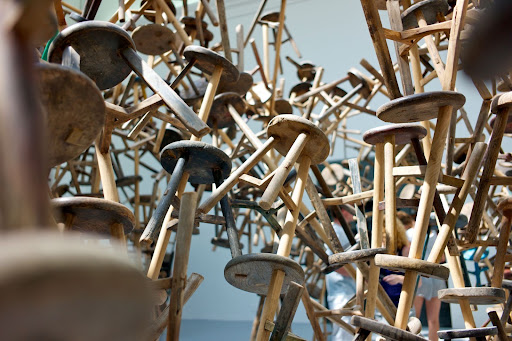
Michael Korcuska / Flickr; Attribution-ShareAlike 2.0 Generic (CC BY-SA 2.0)
Ai Weiwei structured 886 antiquated stools in a rhizomatic network, each stool representing a Chinese family whose traditions are somewhat lost in today’s evolving society. “Wooden stools are something so conventional in the context of Chinese culture that you wouldn’t expect them to be used in such an artistic form. In that sense, it becomes unconventional,” said Michele Wu ’24.
“According to what?”
These three words by Ai Weiwei started as the name of his collection at the Mori Art Museum in Tokyo, Japan, but now appear at nearly every one of his exhibitions worldwide. As China’s most vocal political commentator and most provocative modern artist, he has shattered norms and spurred governmental dissent, making art come alive.
Ai Weiwei was born on August 28th, 1957, in Beijing, China. Early in his childhood, Ai and his family were exiled to the province of Xinjiang, due to his father being accused as a rightist during Chairman Mao Zedong’s anti-intellectual campaign. During this campaign, the Chinese Communist Party, or CCP, killed or exiled hundreds of thousands of individuals who sought to hold the party accountable for its mistakes.
“When I was a young boy, the world to me was a split screen,” he wrote in his memoir 1000 Years of Joys and Sorrows. “In that information-deprived era, personal choice was like floating duckweed, rootless and insubstantial.”
Out of the more than 720 artworks Ai has created or oversaw throughout his career, four stand out in epitomizing cultural development and political conviction.
Sunflower Seeds, 2008-10
Ai Weiwei’s work most famously involves the mass accumulation of objects, ranging from bicycles and backpacks to crabs and sunflower seeds. And although his driving motivation is to challenge China’s government and societal issues, he does not forget to celebrate the people.
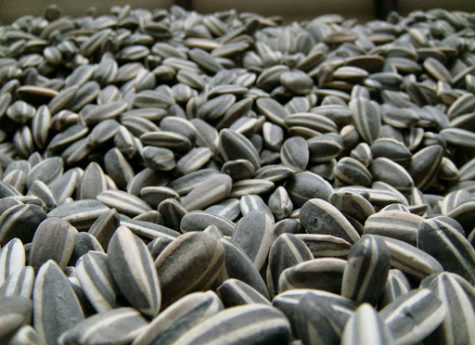
Perhaps his most prominent work is Sunflower Seeds, or 葵花籽, which consists of more than 100 million porcelain sunflower seeds, each of which alludes to an individual and collectively represents the masses. It encapsulates the discovery of individuality among a myriad of seemingly identical citizens, each represented by seeds.
Totalling over 150 tons, each seed is a unique, handcrafted construct made by “cottage” porcelain specialists rather than in a large-scale factory.
“Ai Weiwei’s work is incredibly conceptual,” said Ms. Gayle Asch, art teacher at Bronx Science. “There’s always meaning behind it, whether it looks simplistic or complex.”
Sunflower Seeds is currently at the Tate Museum in London, England.
Bang, 2013
The inclusion and pursuit of cultural values and historical knowledge in art had long been prohibited since the Chinese Cultural Revolution. To combat this prohibition, Ai, over the span of a decade, integrated cultural furniture pieces in a three-part series.
Arguably the most elaborate out of the three works, Bang involves handcrafted and somewhat shabby wooden stools. These three-legged stools were a staple in nearly every Chinese household, withstanding the toil of domestic life over several generations.
Here, Ai collected 886 wooden antique stools, arranging them in a tangled, rhizomatic fashion to symbolize Chinese families and their place in a rapidly transforming world. In smaller variations of Bang, he even gathered wooden stools dating back to the Qing Dynasty to further the balance between old and new.
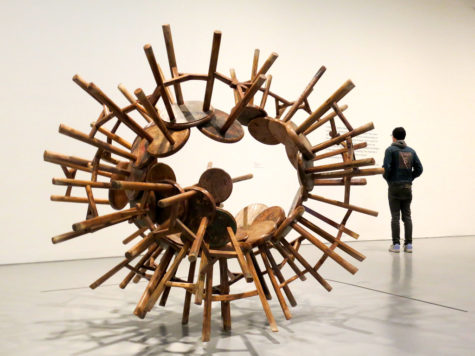
In the last few decades following the Cultural Revolution, China’s modernization and mass production resulted in these antiquated stools becoming nearly obsolete. Instead, plastic and metal variations took its place.
“After learning about the meaning behind this artwork, I was able to better understand that while modernization and mass production represents our society’s development, it comes at the expense of abandoning certain parts of culture and tradition,” said Max Hawkins ’24.
The 2008 Sichuan Earthquake Series
On May 12th, 2008, an earthquake struck Sichuan, China and the surrounding southwestern region. In a matter of minutes, it claimed more than 87,000 lives, more than 9,000 of which were schoolchildren.
The country demanded answers. Why did more than 7,000 classrooms collapse while other buildings remained intact? Or, in the words of Ai Weiwei, “Was the death toll simply evidence of a corrupt political system: a system that believes life is insignificant and that tragedies are easily erased?”
While the Chinese government pledged to investigate the collapse of so many schools, the promise was shallow and short-lived. The names of the victims were never released, and authorities claimed that many deaths were due to natural causes.
Ai decided to seek answers himself, starting with his online Sina blog. His post, reading “This is my question: Where are those lives?” caught the attention of over 100 people, and in the few days before his blog was shut down, a citizen investigation team was formed.
During his investigation, Ai and his team visited the cities hit by the quake, knocking door to door requesting for the victims’ names, dates of birth, and schools they attended. A year later, they had 5,219 names of children whose tragedies could have been prevented if not for government mismanagement.
To commemorate the victims of the quake, Ai created Remembering, an installation of 9,000 vibrant backpacks on the façade of the Haus der Kunst art museum in Munich, Germany. Spelling out to read “她在这个世界上开心生活过七年,” the statement parallels the backpacks among earthquake debris encountered in Ai’s investigation, and translates to what a mother of a victim had written to him: “All I want is to let the world remember she had been living happily for seven years.”
On the other hand, Straight consisted of ninety tons of steel rods from the quake sites that Ai and his team, each individual piece straightened and molded into rippling shapes to imitate the seismic fault lines that school buildings were built upon. Ai intended to create a poignant reminder for his viewers, directly conveying that China’s construction industry and civil engineering laws were in grave need of reform.
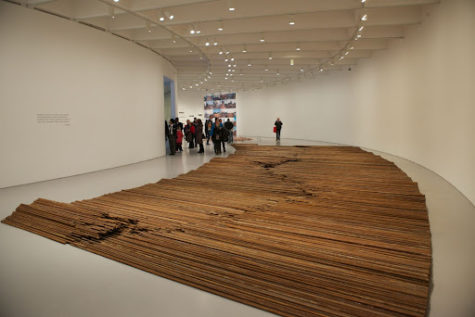
“It’s also that sense of helplessness. Because here you have all this material, and what did it do? It caused no protection for anybody. It’s frightening when you look at it that way,” said Helen Dickerson, a visitor at the exhibition.
In an era of conformity and censorship, dissident voices like Ai’s were considered a threat to the Chinese government. Blog shutdowns became arrests, and police interrogations became psychological abuse. The more the country cracked down on free speech, however, the more visible Ai Weiwei became to the public eye.
@Large, 2014
After a secret detainment, an eighty-one day arrest, and the revoking of his travel rights by the Chinese authorities, Ai Weiwei could only reach his international audience from afar — through remote blueprints and cargo shipping.
“The misconception of totalitarianism is that freedom can be imprisoned,” said Ai. In reality, “when you constrain freedom, freedom will take flight and land on a windowsill.”
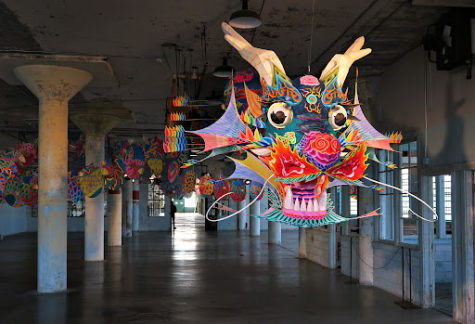
This time, his mind’s destination was Alcatraz. The infamous prison rests on an island off the coast of San Francisco, caging decades of tensions surrounding incarceration, protest, and war.
The process turned out to be a lot more risky and complex than expected. With Ai Weiwei practically ostracized from the Chinese government, arts organizations and Alcatraz directors took extra precautions to secure permission from the U.S. Department of State before turning Ai’s ideas into reality. “We didn’t want to create an international incident,” explained Frank Dean, general superintendent of the Golden Gate National Recreation Area.
From floor to ceiling, the prison’s most famous exhibits include an ornate dragon kite and hundreds of LEGO portraits.
The dragon kite, With Wind, along with other stylized birds and flowers, uses vibrant hues and paper to create a striking impression of Chinese culture. Upon a second glance, however, these kites are intricately attached onto the prison’s ceilings, forever trapped inside and unable to fly.
The floor exhibition, Trace, uses more than 175 LEGO portraits of individuals who have been imprisoned or exiled for political dissent. Examples include Edward Snowden, Haile Woldetensae, Shiva Nazar Ahari, and Ai Weiwei himself. The use of more than 1.2 million LEGO pieces aim to create a pixelated image of the political prisoners, depicting surveillance and censorship.
Along with other exhibits involving reflective panels, ceramic flowers, and sound installations, Ai Weiwei manages to walk a line between freedom and confinement in this piece — all while being trapped in the grasp of the Chinese government himself.
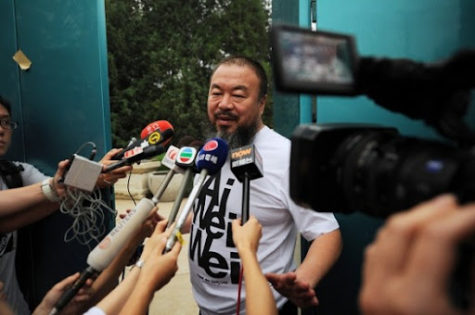
Where is Ai Weiwei Now?
In 2015, more than four years after the initial barring of his travel rights, Ai Weiwei’s passport was returned. Since then, the artist has been exiled, living in places from Berlin, Germany to Cambridge, England. As of 2021, he lives in Montemor-o-Novo, Portugal.
“Ai Weiwei has sacrificed a lot for being a dissident in China,” said Zhao Zhao, another contemporary Chinese artist.
While Ai has shifted to writing, most recently publishing his memoir in 2021, he lives on through every facet of the art world. In 2012, Alison Klayman directed an award-winning documentary, Never Sorry, depicting Ai Weiwei’s artistic process and clashes with the government in its rawest form.
And of course, nothing carries his legacy better than his artworks, forever denouncing government corruption while bringing new meanings to art and life.
“The misconception of totalitarianism is that freedom can be imprisoned,” said Ai. In reality, “when you constrain freedom, freedom will take flight and land on a windowsill.”
Charlotte Zhou is an Editor-in-Chief for ‘The Science Survey.’ In addition to writing and editing articles, she constructs the online crossword and...
